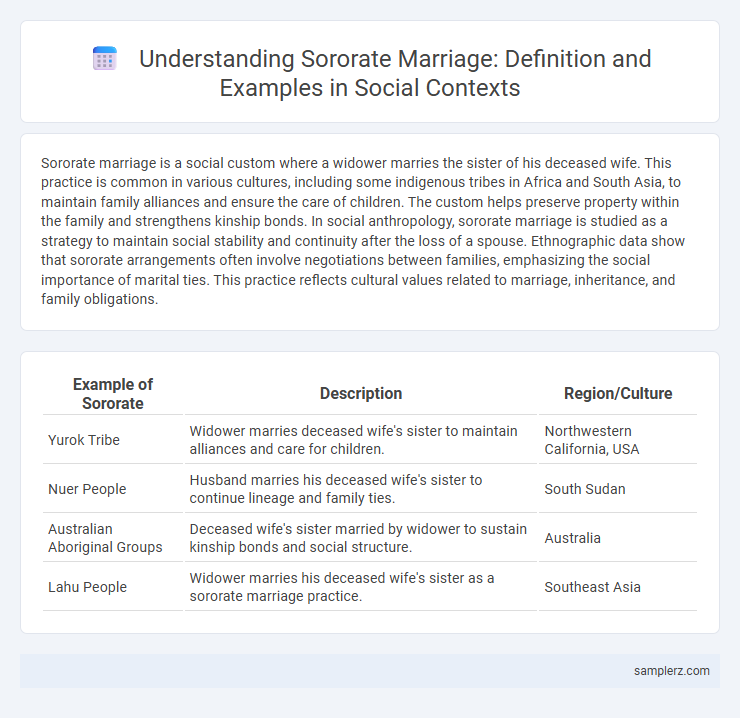Sororate marriage is a social custom where a widower marries the sister of his deceased wife. This practice is common in various cultures, including some indigenous tribes in Africa and South Asia, to maintain family alliances and ensure the care of children. The custom helps preserve property within the family and strengthens kinship bonds. In social anthropology, sororate marriage is studied as a strategy to maintain social stability and continuity after the loss of a spouse. Ethnographic data show that sororate arrangements often involve negotiations between families, emphasizing the social importance of marital ties. This practice reflects cultural values related to marriage, inheritance, and family obligations.
Table of Comparison
| Example of Sororate | Description | Region/Culture |
|---|---|---|
| Yurok Tribe | Widower marries deceased wife's sister to maintain alliances and care for children. | Northwestern California, USA |
| Nuer People | Husband marries his deceased wife's sister to continue lineage and family ties. | South Sudan |
| Australian Aboriginal Groups | Deceased wife's sister married by widower to sustain kinship bonds and social structure. | Australia |
| Lahu People | Widower marries his deceased wife's sister as a sororate marriage practice. | Southeast Asia |
Introduction to Sororate Marriage Practices
Sororate marriage practices involve a man marrying the sister of his deceased or infertile wife to maintain familial alliances and ensure offspring. This custom is prevalent in various indigenous societies, including some communities in Africa, South Asia, and the Middle East. Anthropological studies highlight sororate as a social mechanism that reinforces kinship ties and provides social security for the widow's family.
Historical Context of Sororate in Different Societies
Sororate marriage, historically practiced in various societies such as the Nuer of South Sudan and some Native American tribes, involved a widower marrying his deceased wife's sister to maintain alliance and social cohesion. In ancient Mesopotamian cultures, sororate unions reinforced family bonds and ensured the care of children within kin groups. These practices highlight how sororate marriage functioned as a social mechanism for continuity and stability across diverse cultural contexts.
Cultural Significance of Sororate Marriages
Sororate marriages, where a man marries his deceased wife's sister, hold deep cultural significance in many societies, reinforcing familial alliances and ensuring the care of children within the extended family. This practice is prevalent among indigenous communities, such as certain African tribes and Inuit groups, where it upholds social stability and continuity of lineage. By preserving kinship ties, sororate marriages contribute to social cohesion and the transmission of cultural values across generations.
Reasons Behind the Practice of Sororate
Sororate marriage often occurs in societies where strong kinship ties and economic alliances are crucial for family stability and social cohesion. This practice ensures the continuation of lineage, childcare, and mutual support between families when a wife dies or is unable to bear children. Sororate marriage also helps maintain peace and strengthens inter-family relationships by preserving existing bonds through familial networks.
Notable Examples of Sororate in History
Notable examples of sororate in history include ancient Mesopotamian societies where a man married his deceased wife's sister to maintain alliances and ensure progeny within the family. Similar practices were recorded among the Nuer people of South Sudan, where widowers married their late wife's sister to preserve kinship ties. In medieval Europe, sororate marriages were occasionally used to solidify political alliances between noble families after a spouse's death.
Sororate Marriage Among Indigenous Communities
Sororate marriage, a social practice prevalent among indigenous communities such as the Nuer of South Sudan and certain Native American tribes, involves a widower marrying his deceased wife's sister to preserve family alliances and ensure continuity of offspring. This custom strengthens kinship bonds and maintains social stability within these societies by reinforcing existing familial obligations and support networks. Anthropological studies highlight sororate marriage as a crucial mechanism for inheritance rights, child-rearing responsibilities, and economic cooperation in indigenous cultural frameworks.
Contemporary Cases of Sororate Marriage
Contemporary cases of sororate marriage persist in various societies, particularly among indigenous groups in Africa and South Asia, where marital alliances reinforce tribal bonds and ensure family continuity. In regions like Ethiopia's Afar community, sororate marriage remains a culturally significant practice to maintain social harmony after the death or infertility of a wife. Modern legal systems often coexist with these customs, creating nuanced interactions between traditional sororate arrangements and formal marriage laws.
Impacts of Sororate on Family and Social Structure
Sororate marriage, where a widower marries his deceased wife's sister, influences family dynamics by reinforcing kinship ties and providing emotional and economic stability. This practice often strengthens alliances between families, ensuring continuity of lineage and resource sharing within the social structure. It can also affect inheritance patterns and social roles, preserving family cohesion in patriarchal societies.
Legal Perspectives on Sororate Marriage
Sororate marriage, a traditional practice where a widower marries his deceased wife's sister, presents complex legal challenges in many jurisdictions. Some countries explicitly recognize sororate unions under customary law, granting them legitimacy and inheritance rights, while others restrict or prohibit them due to modern legal frameworks focused on monogamy and individual consent. Legal perspectives on sororate marriage often balance cultural customs with statutory marriage laws, influencing family rights, succession, and social obligations.
Changing Trends and Decline of Sororate Practices
Sororate marriage, historically practiced in various cultures such as among the Nuer of South Sudan and certain indigenous tribes in India, involved a husband marrying his deceased wife's sister to preserve family alliances and care for children. Changing social norms, increased emphasis on individual rights, and legal reforms have significantly contributed to the decline of sororate practices globally. Modern marriage trends prioritize personal choice and gender equality, reducing the traditional reliance on sororate arrangements for familial or social stability.

example of sororate in marriage Infographic
 samplerz.com
samplerz.com